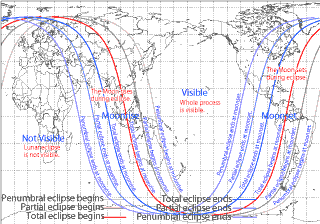Mechanism

The Moon reflects the light of the Sun and shines. Lunar Eclipse occurs when the Moon passes through the shadow of the Earth so that the light cannot reach the Moon. Lunar Eclipse can be Penumbral when the Moon is in penumbra, Partial or Umbral when the Moon is in umbra, and Total when the whole Moon is in umbra. Lunar eclipse is visible where the Moon is visible.
In penumbral eclipse, it is true that the Moon looks slightly dark, but you will not notice the difference unless you look closely. Therefore, we do not count the penumbral eclipse as a lunar eclipse in Reki Yoko or printed version of Calendar and Ephemeris. Please use Local Prediction of the Lunar Eclipse if you need information.
- Local Prediction of Lunar Eclipse
- Solar & Lunar Eclipse (Japanese Only)
- Pictures (Japanese Only)
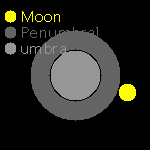

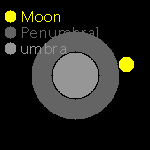
Rising and Setting during Eclipse
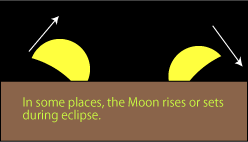
The rising and setting of the Moon usually refer to times when the center of the Moon touches the horizon. However, since the Moon is always full when the lunar eclipse occurs, the times when the upper limb of the Moon touches the horizon are used in the local prediction of lunar eclipse.
Eclipse Maps
Lunar eclipse progresses in the same way wherever the Moon is visible. So you can judge the visibility with moonrise and moonset times. Eclipse Map shows the area using moonrise and moonset lines.
"Visible" shows the area where whole eclipse is visible. Every time you cross the line, the Moon is under the horizon at time of certain phenomena and not visible.
Glossary
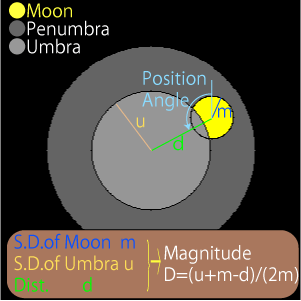
- Position Angles (P.A.)
In Reki Yoko, we use V + 180° rather than V at the beginning and at the end of total eclipse. At the beginning of the total eclipse, V + 180° shows the direction of the last illuminated part of the Moon, ant at the end, it shows the direction of the first illuminated part.
- p : Direction of the center of Umbra with respect to the center of Moon, measured counterclockwise from celestial north
- q : Direction of zenith with respect to the center of Moon, measured counterclockwise from celestial north
- V : Direction of the center of Umbra with respect to the center of Moon, measured counterclockwise from zenith, i.e. V = p - q.
- Other terms
- S.D. : Semi Diameter
- Dist. (d) : Angular distance between the centers of Umbra and Moon
- Mag. (D) : Magnitude = Percentage of diameter of Moon covered by Umbra. D = (Semi Diameter of Umbra + Semi diameter of Moon - d) / (Diameter of Moon)
Diameter of Moon is geocentric value.
